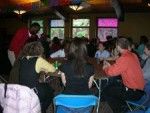Diversity Council Tackles Hot Topics

The theme of “acknowledging and addressing the disparity between quantitative data and experience” was the focus of this week’s Diversity Council meeting, which took place Tuesday, February 20 in the O’Connor Campus Center (The Coop).
Carolyn Hsu, Assistant Professor of Sociology, outlined the results of the Campus Climate Survey taken by Colgate students in 2003 for the members of the faculty and student body in attendance. This survey – which consisted of 1,249 people, or 43.3 percent of the student body – measured the general satisfaction and quality of academic experience, with an emphasis on racial climate.
The findings generated some important conclusions about dversity at Colgate. In terms of satisfaction with academics and life in general, white students reported being significantly happier with their Colgate experience. On a seven to one scale, with seven representing the most satisfaction, white students on average rated their satisfaction a 5.7. Black students averaged at a 4.8, making them the least “happy” minority group on campus. These results relate to general satisfaction, though academic experience yielded a very similar outcome.
Professor Hsu went on to pinpoint more specific statistics reflected in the data collected. There was a significant disparity in the level of respect students felt they received from their peers among the racial groups surveyed. On average, black students reported feeling much less comfortable and satisfied in the peer academic environment.
More information was presented regarding social aspects of Colgate life. Students were asked to list five friends and what race they were. Professor Hsu admitted that the findings were unexpected. In general, it was to be expected that fewer white students would have friends of a different race, given the University’s demographics; however, the number of white students who reported having only white friends was well above the level of probability. This led the Council to believe that, in 2003 at least, students who seemed to self-segregate by race were mostly white.
Taking into account the vast amount of data collected, the Diversity Council concluded that there were “Three Colgates” on campus. The first was a mostly white, affluent, hard-partying and generally happy group of students. The second was the moderate group that worked hard, partied a little, but not excessively, and was more or less satisfied with the Colgate experience. And the third group was the black student population, which reported feeling the least happy across the board despite high academic aspirations. Although they were invested and involved, these students seemed to perceive Colgate in profoundly different, mostly negative ways.
Since the advent of the Diversity Pre-Planning Workshop and the Diversity Council, important programs have been instated. The Diversity Initiative is working to generate a University-wide effort to improve the climate in classrooms and in admissions, encouraging the recruitment of diverse faculty members and administrators. The Residential Education Vision is a way of making sure the learning that takes place at Colgate beyond the classroom is intentional. With the First-Year Experience, Sophomore-Year Experience and Broad Street Initiative, there has been more problem-solving dialogue among students and faculty members.
However, from group discussions that took place after the survey was presented, it is clear that there is much to be accomplished. One first-year noted that the Multi-Cultural Open House, with its effort to have students of color welcome other prospective students of color, was a great way to develop a sense of community; however, he also noted that an accurate representation of the Colgate experience is more difficult to confront, citing being the only minority in a class of white students as an example.
“Colgate needs to be truthful about diversity,” Women’s Studies Program Assistant Cassie Quirindongo ’06 said. “We can’t bring students of color here and show them only color – we need to show them Colgate. From the Multi-Cultural Open House, it is easy to think this school is more diverse than it actually is.”
Director of Counseling and Psychological Services Mark Thompson acknowledged that Colgate has been making steps in the right direction to foster a better environment for people of color.
“I am encouraged and hopeful about each class increasing its percentage of students of color,” Thompson said. “Eventually, we will have over 20 percent, which will make things easier. We need to work on what to do in the meantime until we get there.”
Among the most frequent ideas brought up by the students, faculty and administrators in attendance was the need to make the Colgate community aware of these discouraging findings presented in the Campus Climate Survey. Many agreed that the first step to change is awareness.






